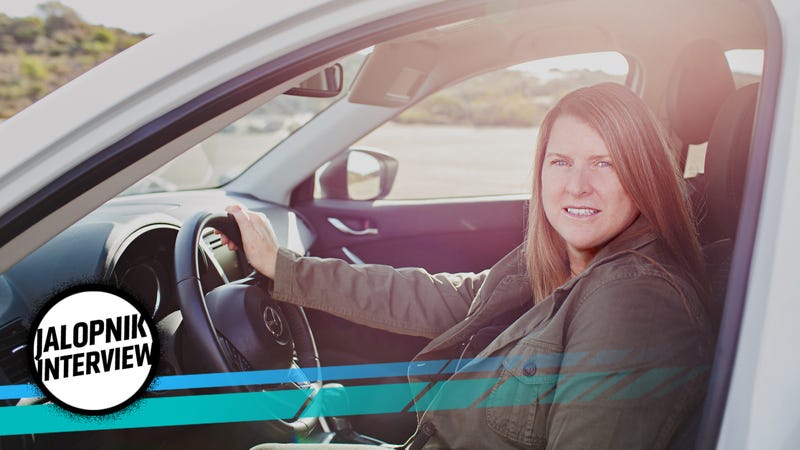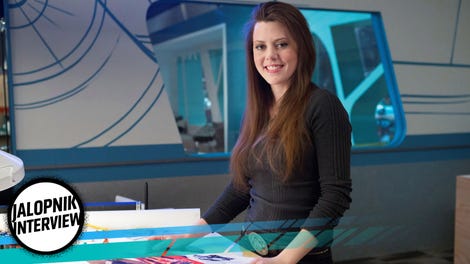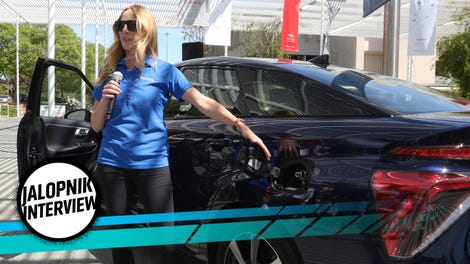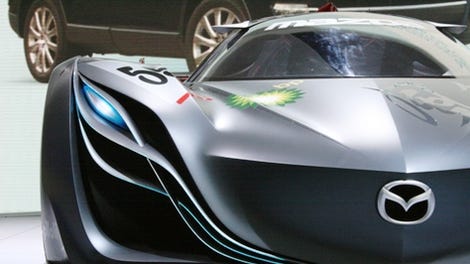
Most of us put a lot of care into the clothes we wear. What defines our style is important to us, so why wouldn’t that same line of thought carry over to the cars we drive? Taste, design and looks in a car are all highly subjective. Nailing down what a customer wants can be a tricky business, because sometimes even they have no idea what they’re looking for. Teresa Spafford has made it her life’s work to create cars stylish enough to wear.
[Welcome to What It Takes, a column devoted to highlighting all of the kickass women in the car industry. Know someone with an awesome story to tell? Email me at kristen@jalopnik.com!]
Advertisement
Teresa is a design manager for color materials, finishes and advanced design planning at Mazda. She’s had her hands on most of the new Mazdas you see driving around on the roads today and also worked on the very special and extremely cool Mazda Furai (RIP).
(Note: this conversation has been edited for grammar, brevity and flow purposes.)
Kristen: Were you a car person before you went to school for design?
Teresa: My father is a car nut. He just loves them all. He can appreciate everything from a rally car to a Ferrari. He just thinks they’re all fantastic. He used to just take us to car shows, airplane shows—all kinds of moving things. Trains. If he saw something special driving down the road, he’d always point them out. Often times, a U-turn, and off we’d go chasing the car down, totally forgetting where it was that we were supposed to be going.
Advertisement
I‘m from Australia and we’d go out in the Outback and camp out. My dad had lots of friends who were farmers, so we’d go out on their farms and he’d let us drive the farm vehicle. We’d sit on his lap and steer and that, to me, was one of the most thrilling experiences of my whole life.
Kristen: What are you responsible for at Mazda?
Teresa: It’s two kind of separate jobs… Color materials and finishes: all the interior and exterior colors and materials that go onto the cars, so all the body paint colors, trim pieces, all those kind of finishes that you see on the exterior colors, things like that. Then everything on the interior: leather, fabric, carpet, headliner, all the decoration metal pieces. Pretty much everything inside and out I have a hand in.
Kristen: How do you go about choosing all the colors and trims?
Teresa: It’s a pretty challenging process, being that our product life cycle is anywhere to five to eight years. You have to be able to forecast [the vehicle] much further out. Sometimes that means what you’re designing isn’t really for today, but [for the] launch [of] the vehicle. It’s kind of like you got to design for the longevity, but also the immediate.
It’s also about the feel. It’s also about the durability [of the materials] and how it works with you in different stages of your life. It’s a pretty complex puzzle to solve, but in the end, it has to be something that really appeals to your taste.
Kristen: Would you say that’s the hardest part of your job: anticipating styles and trends and what will more long-lasting images and materials?
Teresa: That’s one of the most interesting parts, actually. I think the hardest part is actually when you [have to] convince management [that] this is the direction things are going. [It’s] really trying to first come up with the design, understand what’s going on and then be able to leverage all the research and the information that you’ve gathered and why the design is the way it is to help bring everybody on board.
As designers, we bring our heart and soul to work every day. We work from a very personal passion. To have a career as a designer, you need to have a deep well of that. In the automotive industry, there are maybe 20 designers working day and night to get their design selected to be able to be the one to move that design to production.
Advertisement
Not getting picked is what keeps those other 19 going, but the reality is those 19 other designers are influencing that one designer. What they did pushed that designer forward. What they contributed brought everything to a higher level. Possibly even some of what they did design will make it into the final design, too.
All of our designers at Mazda have a very clear understanding of what Kodo Design is and what it isn’t.
Kristen: Are there any current Mazda products on the road I would know that have your handprints on them?
Teresa: Pretty much all of them do. As far as color material design, I’ve been really lucky to say that I’ve got my hand prints on all of them. I didn’t necessarily do every part of all the vehicles. A good example would be the Soul Red and Soul Red Crystal. Basically, I led the work on that very, very, very early on say this is something that we need to be doing, then putting it on all of our show models and concepts internally. Also, on show cars that were on the stand. Then when it comes to the CX-9, basically, that vehicle has my hand prints all over it, from interior the exterior.
Kristen: You were also involved with the Mazda Furai, correct?
Teresa: Yeah. That was one of the most amazing projects that we did. It was a beautiful car. It had so much meaning, just from a technical standpoint. It was a track car.
Advertisement
That car—granted that was in the Nagare Era—people got it. Maybe they didn’t understand the Nagare, but they didn’t have to understand it. They didn’t even have to care about Nagare. They understood it because overall it was just a beautiful car.
Kristen: What were you specifically involved with for the Furai?
Teresa: I did all the color material design for that, then, collaboratively, the interior design as well.
Kristen: That flat gray on the outside, the red design elements and the blue light—that was all you?
Advertisement
Teresa: Yep, that was all me. We had a whole theory about how we used the colors. On a race car, you have so many logos and so many corporate sponsors. How do you manage all of that? We came up with this whole system of how to handle that.
We were exploring wind, the movement of wind and what effect that would have on the surface. How do you either create resistance or eliminate the resistance? In this case, we were trying to eliminate resistance and how that would cut away the surface and what that wind would look like. How does affect the interior?
One of the things that I was inspired by were prayer flags. When you look on the mountaintops in Nepal, especially Mount Everest, at the camps, they put up the prayer flags, and you see them waving in the wind. Their belief is that when the wind blows, it carries the words of the prayers into the air to spread the blessings or prayers.
Advertisement
I was like, wow, that’s a really cool idea. Basically, from the driver’s seat to the passenger seat, you can see the airflow. It’s like a clean line that goes and splits like its spreading that prayer across out to the other door, out across the vehicle. You know, beyond. The good feeling we were giving from the vehicle—the driving experience—it was going to be basically: once you open up those doors and the people got out, that would be expressed. I don’t know, it’s pretty geeky.
Kristen: Not at all! I think it’s awesome.
Teresa: I get a little shy talking about that because I’m actually very humbled by the fact that I get to do this work. This is something that I set out to do when I was in college—that I wanted to do—but there was no training in any schools in the United States to do this.
Advertisement
I met with some professionals who were already doing this for different companies around the western U.S. As soon as I discovered this was a job that a real person could have, I said this is what I want to do.
Kristen: That’s how you got into this line of work?
Teresa: I totally stumbled up on it. I came down here with one of my college classes. Every studio that we walked through, they said, “Here’s exterior design. Here’s interior design. Over there, that’s color material design.”
I was like, “Why is that over there? Why are you not showing us that?” They felt like it was more glamorous or wonderful to show the exterior because that was the easy thing, I think. That was the easy thing for them to show us.
Advertisement
Color material design is very complicated. You have to design and create that look. Then you have to be able to back that up. Everybody picks out their clothes every day and decorates their house. Those are all colors and materials and finishes. If we can all do that for ourselves in our daily lives, how’s that going to work on a car?
After I visited all these studios, I contacted them and said, “Can I come back for a personal visit and learn more about this one aspect of the design process because I really think this is something that’s for me?” I did that and then I discovered it was for me.
It wasn’t easy to break into. It was very, very hard. There are very few positions. I used to say—and I don’t know if it’s true now, but from my blank estimate—there are probably less than 500 people in the world who do what I do for car companies. Think about that. Five-hundred jobs. It’s very competitive. I know if I were to leave this job, there are 500 people behind me who would just pour into this position.
Advertisement
As a woman in a male-dominated automotive industry, it can be a daunting task to put yourself forward. Women, for years, weren’t supposed to even know how to drive or we’d get told we’re not as good at it. I mean, look at what female race car drivers have had to go through to be seen, heard and counted as equal. It’s kind of everywhere, but it’s not something that you can blame on the car industry alone.
I think it’s slowly changing but I don’t think it’s quite as simple as just being tenacious and just bucking the system. It’s not that simple. I think you have to have the skills.
I do know there are also an amazing amount of women who have just put their head down and done the hard work. They’re doing it in spite of the other societal messages that they’ve been given. They’re doing it because they believe they have a right to do what they love to do.
Advertisement
I have just as much right. That doesn’t make me any more special, it just means I get to work just as hard as the person next to me, be they a man or a woman. More women need to be open to more women coming in. I think this is what men have done over the years: they share. “This stock is really good to invest in.” They share all this information with each other.
Women need to be able to be a part of that as well. I think that’s going to be the next step: making it more open. I think women silently struggle with certain things and they don’t want to be seen as weak. That’s because we’re all silently going through on our own because we think we have to. We think we don’t have the support.
The reality is we can be that support for each other.
















